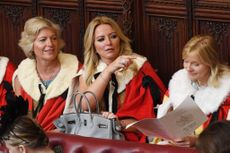The world's central banks will follow the Federal Reserve's example
The US Federal Reserve – America's central bank – has said that it would become more tolerant of inflation and hold interest rates down. Others will follow.

The new era of global central banking is well and truly underway, says Howard Davies on Project Syndicate. Last month Jerome Powell, the chair of the US Federal Reserve, announced that the central bank would become more tolerant of inflation passing temporarily above the 2% target. Last week, the Fed held interest rates close to zero and signalled that they will stay there until the end of 2023.
The new dovishness has been prompted by persistently low US inflation, which has undershot the target 63% of the time over the past decade. Where the Fed leads others will follow. The European Central Bank is currently conducting its own policy review. Some are keen for the Bank of England to follow, but matters are more complicated for the UK: thanks to the persistently weak pound, “average inflation has been more or less on target” in recent years.
Heading towards zero
The Bank of England’s monetary policy committee (MPC) held interest rates at 0.1% and continued the current quantitative easing programme at its most recent meeting. Minutes revealed that policymakers were briefed on plans to roll out negative interest rates in the future. Governor Andrew Bailey this week reiterated that the policy is “in the tool bag” but pushed back against suggestions that they will be brought in soon.
Subscribe to MoneyWeek
Subscribe to MoneyWeek today and get your first six magazine issues absolutely FREE

Sign up to Money Morning
Don't miss the latest investment and personal finances news, market analysis, plus money-saving tips with our free twice-daily newsletter
Don't miss the latest investment and personal finances news, market analysis, plus money-saving tips with our free twice-daily newsletter
“Reading between the lines” it looks like the BoE will not be operationally ready to roll out negative rates until next spring, and then only if it wishes to do so, says Samuel Tombs of Pantheon Macroeconomics. In the meantime, policymakers will lean on more rounds of quantitative easing, which we expect to come around the new year. In the case of a no-deal Brexit, there will be even more quantitative easing and perhaps an interest rate cut to – “but not below” – zero.
MPC members will be studying the experience elsewhere in Europe, where negative interest rates are credited with arresting a deflationary spiral and boosting bank lending, says Tom Stevenson in The Daily Telegraph. Yet there is “scant evidence” that the policy increases economic activity and the effects on bank profits are dire. Beneath a certain level – known as the “reversal rate” – negative rates actually harm economic activity.
Investors adhere to the maxim that you “don’t fight the Fed”, says Jon Sindreu in The Wall Street Journal. The idea is that easy money means stocks are bound to rise. Yet this year’s tide of easy money has not lifted all boats: tech stocks have soared, but some other sectors have slumped. Perhaps there’s a simpler investment prescription for the new monetary era, David Rosenberg of Rosenberg Research tells Barron’s. The Federal Reserve’s “promise to nail rates to the floor” amounts to a giant “‘buy gold’ advertisement”.
-
 UK inflation slowed again in March – but a rate cut could be some months away
UK inflation slowed again in March – but a rate cut could be some months awayThe latest Consumer Price Index (CPI) data came in at 3.2% for March. This was slightly higher than some economists expected, but takes us closer to the Bank of England’s 2% inflation target.
By Katie Williams Published
-
 Pension vs property: which option provides the best income for your retirement?
Pension vs property: which option provides the best income for your retirement?News With the cost of a comfortable retirement on the rise, future retirees need to weigh up which strategy offers the best returns. But is a pension a better bet than property?
By Henry Sandercock Published
-
 Should your business invest in a VoIP phone service?
Should your business invest in a VoIP phone service?Here's what you need to know about VOIP (voice over IP) services before landlines go digital in 2025.
By David Prosser Published
-
 The end of China’s boom
The end of China’s boomLike the US, China too got fat on fake money. Now, China's doom is not far away.
By Bill Bonner Published
-
 What is the future of Royal Mail in the UK?
What is the future of Royal Mail in the UK?With fewer of us sending letters and parcels, the Royal Mail is finding dealing with the nation’s post is an increasingly unprofitable and costly business.
By Simon Wilson Published
-
 What's the secret of Manolo Blahnik's success?
What's the secret of Manolo Blahnik's success?Fashion maestro Manolo Blahnik shows little sign of slowing down at 81, and his company notched up a record financial year in 2022. What is the secret of his success?
By Jane Lewis Published
-
 Michelle Mone's "tough year of pain"
Michelle Mone's "tough year of pain"Michelle Mone liked to portray herself as a working-class heroine who worked her way to the top through grit and determination. But her pedestal is built on sand.
By Jane Lewis Published
-
 Trevor Milton, the Elon Musk wannabe, is jailed for fraud
Trevor Milton, the Elon Musk wannabe, is jailed for fraudThe former CEO of Nikola, Trevor Milton, has been found guilty of lying about the development of the company's electric trucks.
By Jane Lewis Published
-
 Directors should think twice before waiving limited liability
Directors should think twice before waiving limited liabilityShould small-business directors ever provide a personal guarantee in return for bank finance?
By David Prosser Published
-
 Why Russia's economy is doing better than predicted
Why Russia's economy is doing better than predictedSanctions were supposed to strangle Russia’s economy, but it seems to be thriving. What’s going on?
By Simon Wilson Published